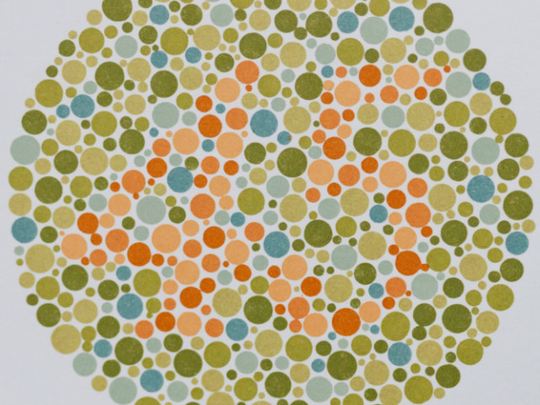
A test conducted by an eye hospital in Dubai to verify the link between diabetes and colour blindness came up with a surprising result.
“We knew that colour vision abnormality is common in diabetic patients but the studies conducted in other countries so far were inconclusive (in proving that diabetes can lead to colour blindess),” says Dr Imran Ansari, ophthalmologist at Moorfields Eye Hospital.
Vision tests on colour blindness done by specialists in other countries have not provided any conclusive evidence, says Dr Ansari. (So far, there have been 30 studies published internationally on colour blindness and diabetes.) “It has long been known that colour vision may become abnormal in diabetics and that this can come on early in the disease,” the Moorfield study notes.
The UAE study result was “very surprising” in that it showed that there was no link between being diabetic and developing colour vision abnormality in the UAE population, says the doctor. “It had no link to the level of sugar control in diabtetics, weight or age,” he says.
This first UAE study however, demonstrated the prevalence of colour vision abnormality in the large majority of the study population in the UAE, but there was no connection with being diabetic.
The UAE study has been presented at two conferences; at the European Association of Vision and Eye Research in France and another in Iceland.
The doctor says it’s a mystery why colour blindness is prevalent in the UAE. “We don’t know why. It (colour vision abnormality) could be because of the exposure to excessive sunlight or Vitamin D deficiency. Vitamin D is a necessary factor in the normal functioning of several pathways in the retina. It needs more research,” says the doctor.
The Eye Hospital had conducted a test on 214 diabetic patients, a majority of them Emirati, and also on expatriates who had not been living in the UAE for long. These participants underwent a detailed eye examination and then the colour assessment test.
This test, known as the Colour Assessment and Diagnosis (CAD), was developed at City University, London. “This test also gives us information on what type and the severity of the colour vision abnormality,’ says Dr. Ansari .
What is commonly known as ‘colour blindness’ is actually a colour vision deficiency where you cannot see colour or cannot make out the colour differences under normal lighting conditions. Colour blindness affects a significant number of people and especially isolated communities with a restricted gene pool.
“Colour blindness is mostly due to genetics and affects between 8 to 10 percent of the male population worldwide,” says Dr Ansari. There is a link between consanguinity or cousin marriages and colour blindness gene. “There is a higher prevalence (of colour blindness) in people who inter-marry,” says Dr Ansari. Mostly, the males are affected. “Females are carriers but are not affected,’ he points out.
The cause of colour blindness is basically due to a fault in the development of one or more sets of retinal cones that perceive colour in light and transmit that information to the optic nerve. While it is more common among men than women, because of the genetic link, eye or brain damage can also produce colour blindness symptoms.
Colour blindness can be stationary or progressive in nature and can be linked to other eye conditions such as age-related macular degeneration. Generally, there are two major types of colour blindness: difficulty distinguishing between red and green and difficulty distinguishing between blue and yellow. Unfortunately, there is no cure for this affliction. “If heredity is the cause, there is no treatment for it. But if there are any metabolic problems or a Vitamin D deficiency, these can be addressed and consequently, the condition can be corrected,” he says.
Colour blindness is usually classed as a mild disability.
Colour blindness can severely impair the lives of those who are employed in a sector where it becomes a signular disadvantage, like a pilot’s, for instance. A pilot has to be able to see certain lights when landing to judge the angle of descent. “Many pilots undergo training and are not aware they that they are colour blind. Eventually, they are denied the (pilot’s) license.”
In everyday life, it affects people in situations where reading a colour is important, such as when driving a car.
Everyone, advises Dr Ansari, should take the online test for colour blindness called the Ishihara Test where you have to distinguish colours on 21 plates. “It is worth doing. It won’t change anyone’s lives dramatically but it is like knowing your blood type,” he says.












